
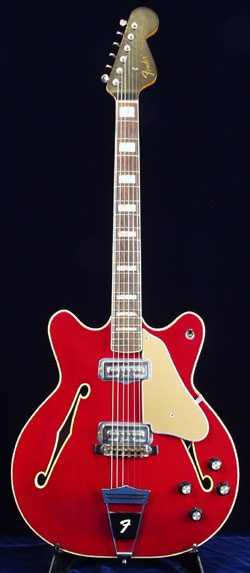
Thinline semi-acoustic guitars were all the rage in the mid 1960s. The blues guitarists that had been playing them since the late fifties were being emulated by the groups of the time. The likes of John Lennon, George Harrison, Paul McCartney and Keith Richards had made the Epiphone Casino very popular - whilst other guitarists were playing the blues on Gibson ES-335s (Eric Clapton, Alvin Lee) or the Guild Starfire (Dave Davies). Less expensive semis such as the Harmony H76 and Hofner Verithin were selling in absolutely huge numbers.
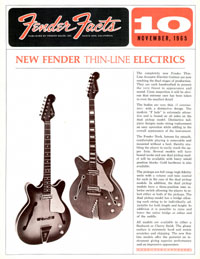
In late 1965 Fender attempted to capture some of the lucrative thin-line semi acoustic market, by announcing a range of semi acoustics of it's own. The range was designed by ex-Rickenbacker guitar designer, Roger Rossmeisl, who left in some Rickenbacker touches like checkered binding, and F-tailpiece. The guitars were all-maple, with pickups designed by DeArmond. Fender had considered the names 'Fender Fantasy' and 'Fender Aztec', but finally settled on Coronado. They were described as follows:
The bodies are very thin (5 centimeters) with a distinctive design. The modern "F hole" is extremely attractive and is bound on all sides on the dual pickup model.
The pickups are full-range high fidelity units with a volume and tone control for each in the case of the dual pickup models. In addition, the dual pickup models have a three-position tone selector switch allowing the player to select either or both of the pickups.
The Coronado series was not actually available for several more months, and was first included in the price list of July 1966. There were single and double pickup six strings, a twelve string and a single pickup Coronado bass. Tremolo's were listed as an optional extra. By 1967 a dual pickup Coronado Bass II was added to the line. Early publicity images show the guitars placed next to sheet music by the Byrds and the Yardbirds - it was clear who these guitars were aimed at.
Launch prices were close to those of the Gibson ES-330TD and Epiphone Casino; the Coronado was a nice guitar, but whether it was in the same league as the fore mentioned models is debatable. The commercial failure of the Coronado - at least in comparison to Fender's solid body models - strongly suggests that the guitar buying public tended to think not. Some 1966 prices are shown below.
| model | 1966 price | list date |
|---|---|---|
| Coronado II | $319.50 | July 1966 |
| Epiphone Casino | $335/$350 Shaded/Cherry | October 1966 |
| Gibson ES-330TD | $310/$325 Sunburst/Cherry | April 1966 |
| Coronado XII | $449.50 | July 1966 |
| Gibson ES-335-12TD | $395/$410 Sunburst/Cherry | April 1966 |
Standard colours were Cherry and Sunburst, and only these were offered in 1966. By 1967 Fender custom colours (DuPont finishes) were also available at a 5% premium, along with some interesting new finishes: the naturally grainy Wildwood and the antique-style Antigua.
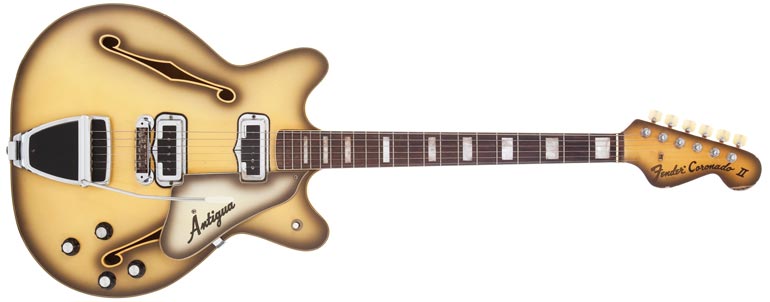
1967 Fender Coronado II in Antigua finish Image Heritage auctions
Fender described their new Antigua finish as follows:
Fender's latest color dimension, the Antigua, puts elegance in the spotlight. This inimitable new finish is a rich, antique white with a halo mist shading which produces a subtle feeling of depth and dimension
The Fender Coronado was widely promoted in 1967, to fill the desire for hollow body thinlines of the 1960s. Fender failed to break into this market in any significant way, however, and they turned their attention back to solid bodies pretty quickly afterwards.
Electric guitar advertisements originally published from 1966 onwards. Click on the images for larger copies. Check out other vintage Fender advertisements
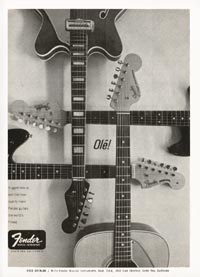
Fender Coronado - Olé (1966)
Fender advert from the middle of 1966 for Fender guitars. Featuring the Stratocaster and Jaguar solid-bodies, the Coronado semi-acoustic and the Concert acoustic.
[more]
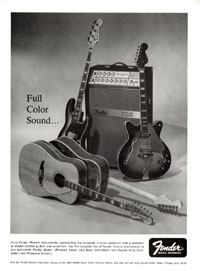
Fender Coronado - Full Color Sound (1967)
From Fender Musical Instruments, representing the complete musical spectrum with a selection of master-crafted guitars and amplifiers. See the complete line of Fender Musical Instruments at any aut...
[more]
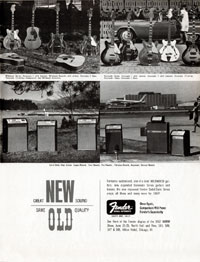
Fender Coronado - Great New Sound. Same Old Quality (1967)
1967 saw Fender pushing some new lines
Fantastic customized, one-ot-a-kind WILDWOOD guitars: new expanded Coronado Series guitars and basses; the new improved Fender Solid-State Series amps; all...
[more]
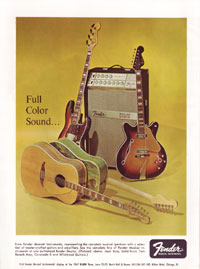
Fender Coronado - Full Color Sound (1967)
Advert for the Fender display at the June 1967 NAMM show in Chicago, USA. It features a number of instruments 'representing the complete musical spectrum': a Jazz Bass, a Coronado II electric acous...
[more]
Fender had been injecting dyes into growing beech trees, in order to create interesting grain effects for the Wildwood acoustic guitar. When harvested the wood was primarily green, blue or brown - giving rise to three actual finishes - Wildwood I (Rainbow Green), Wildwood II (Rainbow Blue), and Wildwood III (Rainbow Gold). The very nature of the process meant that each Wildwood guitar was unique; "the color follows the grain and becomes a rainbow of colors and patterns. This causes each instrument to differ from the next"
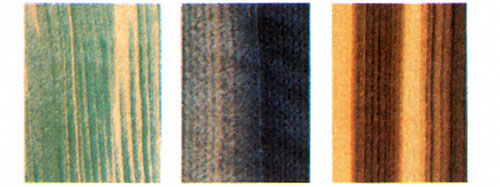
| Model | Coronado I | Coronado II | Coronado XII |
| Available | 1966-70 | 1966-72 | 1967-72 |
| Pickups | One DeArmond single coil | Two DeArmond single coils. By 1970 these are described as Fender pickups. | Two DeArmond single coils |
| Scale | 25½" | ||
| Body | Maple top back and sides. Bound front and back. 16" wide, 1 11/16" deep | As Coronado I, but with bound f-holes | |
| Neck | 21 frets. Width at nut 1 5/8", dot inlays, rosewood fingerboard. | As Coronado I, only bound, with block inlays, and optional maple fingerboard from 1969 | As Coronado I, only bound, with block inlays. Fender curved 12-string headstock. |
| Hardware | Chrome plated. 1 volume and tone control. Optional tremolo. Simple tailpiece with embossed F | Chrome plated (optional gold hardware from '69. 2 volume and tone controls, pickup selector switch. Optional tremolo, but comes as standard with the Antigua II. | |
| Finishes | Cherry and Sunburst 1966-1969. DuPont colours 1967-69 | Cherry and Sunburst 1966-1969. DuPont colours 1967-69. Wildwood finish 1967-70. Antigua finish 68-72. | Cherry and Sunburst 1966-1969. DuPont colours 1967-69. Wildwood finish 1967-70. Antigua finish 68-72. |
The Coronado hardware did vary somewhat - particularly the tailpiece and bridge. The image below shows some of the colours available, and some of the different tailpieces used throughout the course of production. Top Row: Sunburst Coronado I, Cherry Coronado II, blue Coronado XII, White Coronado bass, Sunburst Coronado II. Note the tailpiece. Bottom Row: Rainbow Green Wildwood Coronado II, Rainbow Gold Wildwood Coronado II, Antigua II and Cherry Coronado I. Once again note the tailpiece.
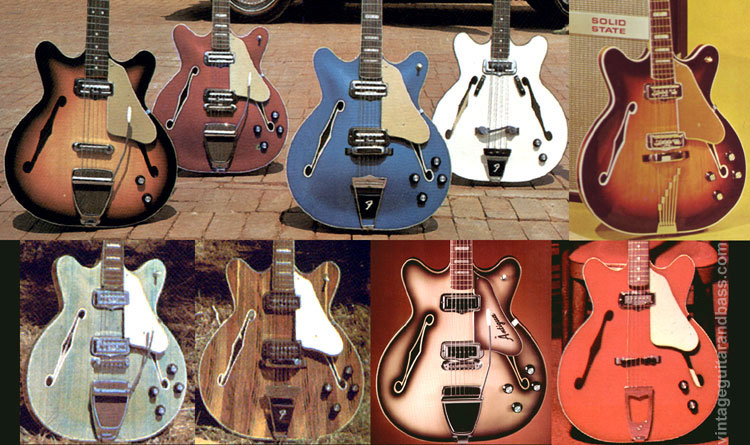
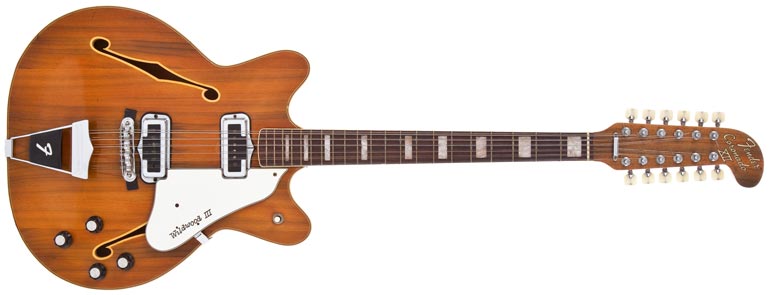 Image Heritage auctions
Image Heritage auctions
The Coronado XII had the same body as the other Coronado guitars, but was fitted with the standard 'hockey stick' style neck as the Electric XII and other Fender 12-string acoustics. The spectacular guitar pictured above is in the Wildwood III (Rainbow Gold) finish.
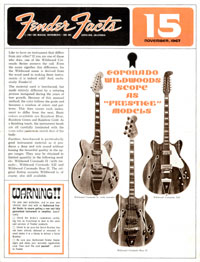
1965 First mention of the new thinlines in Fenders sales leaflet Fender Facts 10, November 1965
1966 Model launch. The Coronado was first listed in the July '66 price list - three models, the Coronado I, II and XII, at $229.50, $319.50 and $449.50 respectively. A single pickup Coronado bass was also listed at $349. Cherry and Sunburst are the only colours listed. An optional tremolo was also available for an extra $55.
1967 Prices were unchanged from '66, with Wildwood II and XII models first listed at $449.50 and $524.50. Custom DuPont finishes are now available at 5% additional cost
1968 Prices still unchanged from '66, with a new model - the Antigua added to the line. Only the II and XII were available in Antigua finish - prices (March '68) $429.50 and $489.50 (the XII dropped to $479.50 in July '68)
1969 By the end of the sixties models were starting to be phased out. The Antigua and Wildwood finishes were the only ones available, with all Coronado Is dropped from price lists. Six string models had an optional maple fretboard (5% extra) and all models had optional gold hardware (15% extra). Base prices are (May '69): Antigua II $449.50, Wildwood II $469.50, Antigua XII $499.50, Wildwood XII $549.50.
1970 Only the Antigua II and XII are listed (April '70): Antigua II $469.50 (left hand $515), Antigua XII $525.
1971 Base prices are unchanged (Jan '71): Antigua II $469.50 (left hand $515), Antigua XII $525.
1972 Feb '72 - base prices unchanged
1973 No Coronado guitars are included in 1973 price lists.
Fender have published regular lists of replacement parts for their instruments, along with part numbers. The lists below are all from June 1969, and are simple lists of parts. Note the different parts list for the Antigua finish. This finish is actually described as Antique rather than Antigua.
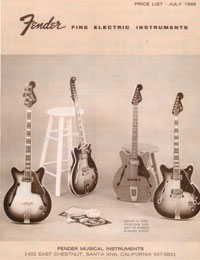
The Coronado is often described as Fender's answer to the Gibson ES-335TD, and in terms of looks perhaps it was. With regard construction and fittings however, it's closest Gibson would be the ES-330TD / Epiphone Casino; unlike most Gibson thinlines these guitars had no central maple block, and single coil pickups instead of humbuckers - or perhaps even the Gibson Crest, with its Wildwood-esque grainy rosewood body and still fully hollow.
No Gibson/Epiphone had a bolt-on neck at that time, so there was no model that could compare like-for-like with the Coronado. Perhaps one of the closest models to the Coronado was the Swedish Hagstrom Viking which resembled the Fender in many ways; but was considerably less expensive. In 1966, US distributor Merson were offering the Viking at just $250.
The Coronado was a great looking guitar, especially the Wildwood examples, and those with checkered binding and block inlays. And it was produced at a time when semi acoustics were all the rage. So why didn't it capture the public's attention? Frankly, the DeArmond pickups were not great - weak if anything - especially in comparison to the P90s and humbuckers fitted to the Gibson/Epiphone equivalents. These rivals, with their set mahogany necks, gave the characteristic 'woody' tones so important to jazz musicians and the powerful output desirable for rock musicians. The Coronado had a strong tendency to feed back - and all this at a price often (slightly) higher than a Gibson. If you wanted a Fender, a Stratocaster seemed a better and considerably cheaper way to go. A sunburst Strat with tremolo cost $281 in July 1966 vs $319 for a Coronado II. And with the likes of Jimi Hendrix demonstrating what a Stratocaster could do...
In 2013, Fender briefly reissued the Coronado - in fact producing a significantly better guitar than the original. The new pickups were far superior, and the the body now had the same feedback-reducing maple block down it's center that Gibson had been using since 1958. These guitars, though no longer in production, are still widely available today.
$2595
$1695
$3800
$3500
$3200
$2400
$3200
$2400
$2400
$4900
£2557
£2200
£2600
€998
£179
£2455
£3500
€2200
€1450